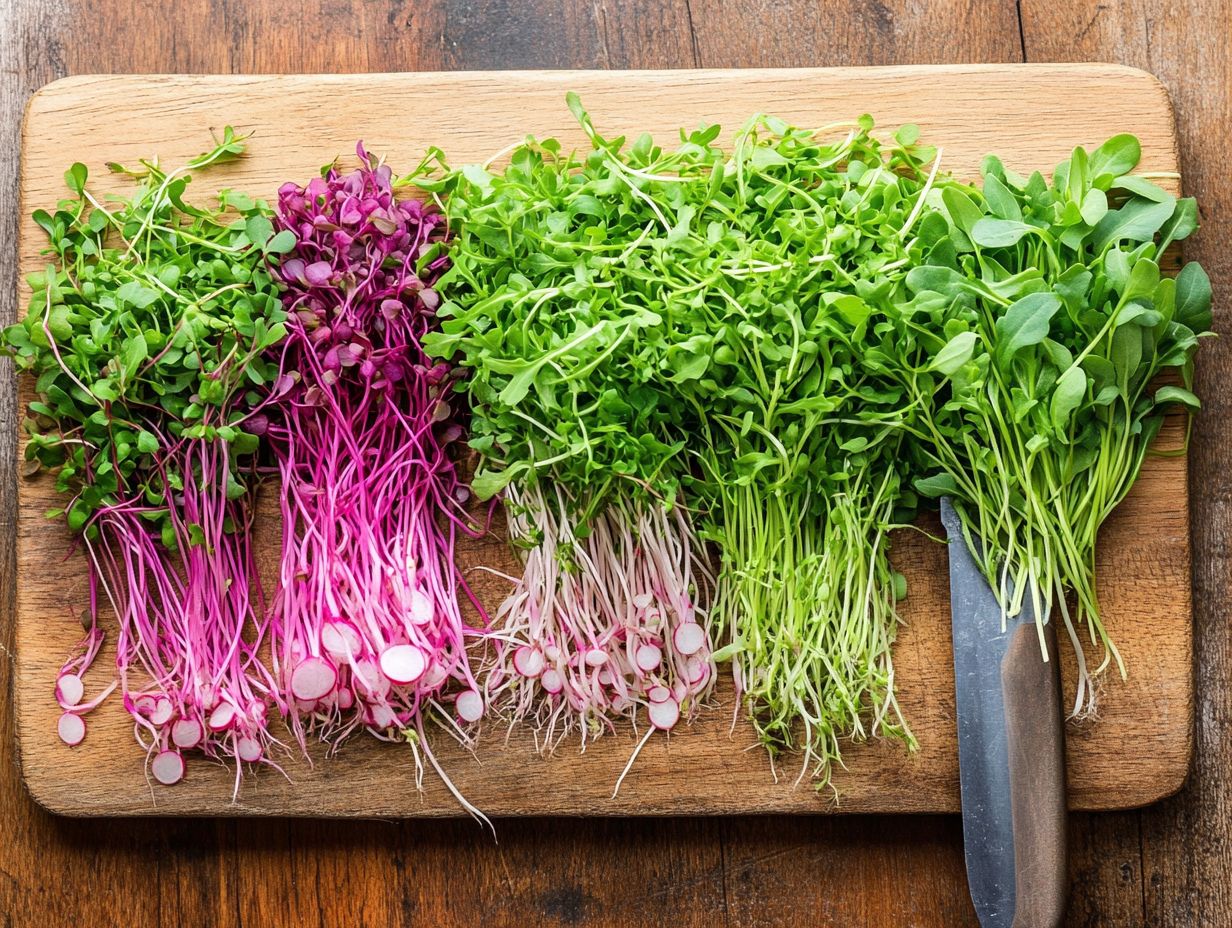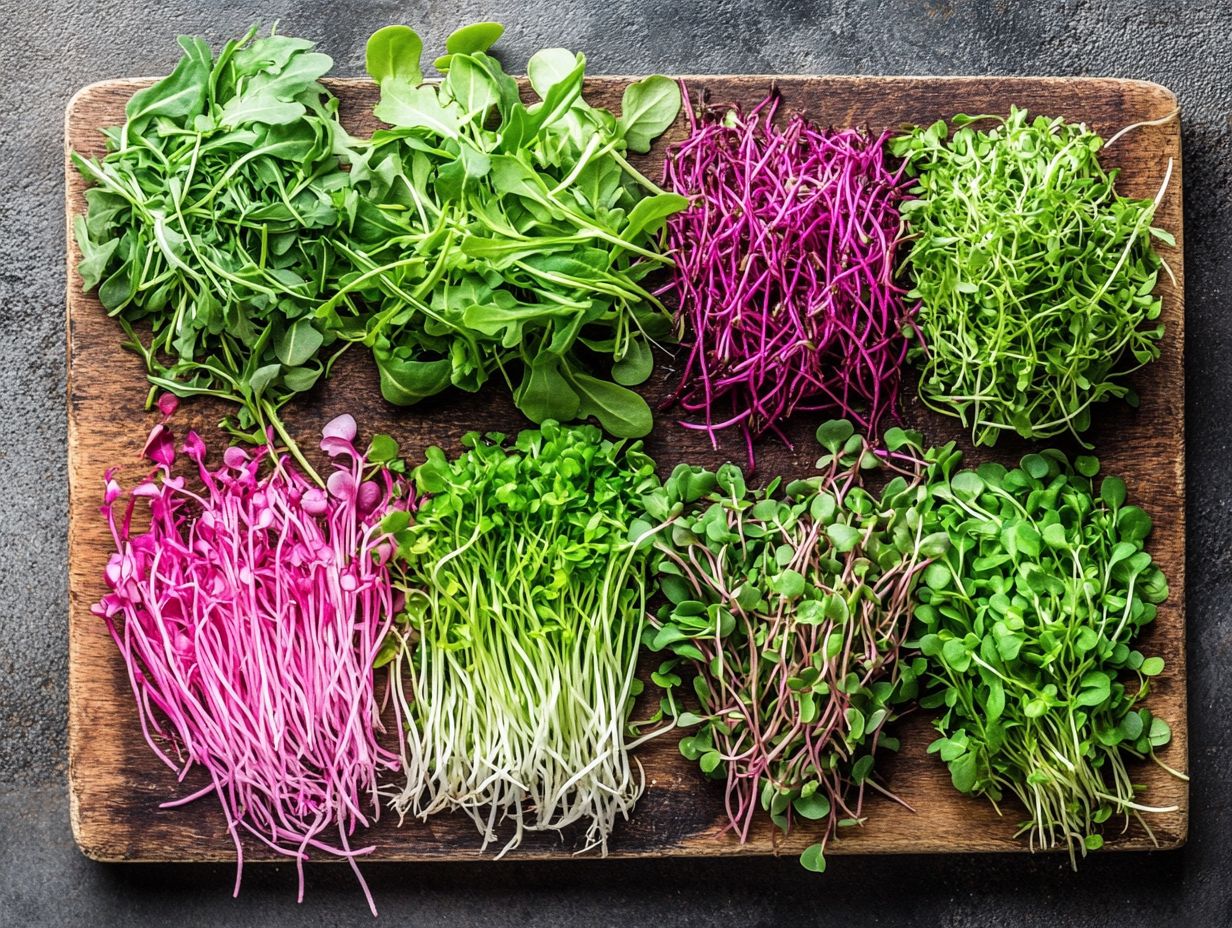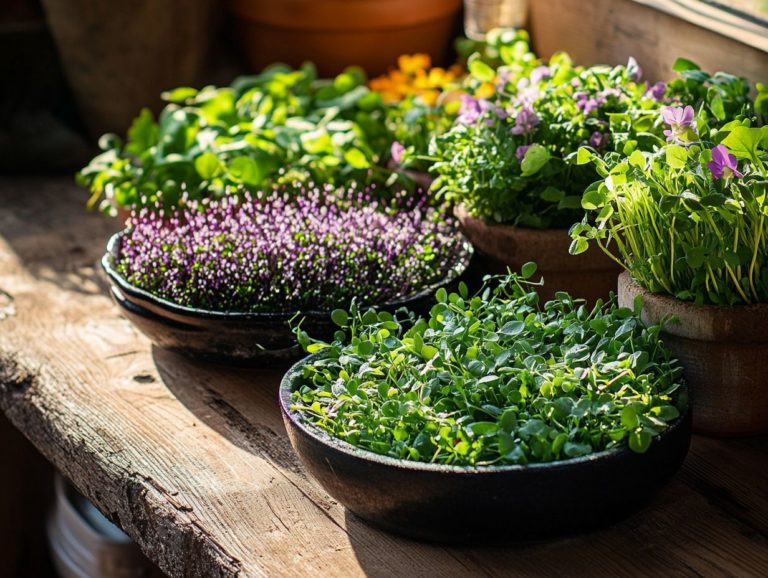5 Microgreen Varieties for a Healthy Diet
Microgreens are tiny powerhouses of flavor and nutrition. Don t miss out on the chance to transform your meals with these vibrant microgreens today! In this article, you ll explore five popular microgreen varieties broccoli, sunflower, pea shoots, radish, and kale each brimming with unique benefits.
You ll discover how to seamlessly incorporate these vibrant greens into your cooking, understand their nutritional advantages, and learn the basics of growing them right at home. We will also discuss potential risks, along with simple ways to weave microgreens into your daily diet. Get ready to boost your meals and health with these incredible little greens!
Contents
- Key Takeaways:
- 1. Broccoli Microgreens
- 2. Sunflower Microgreens
- 3. Pea Shoot Microgreens
- 4. Radish Microgreens
- 5. Kale Microgreens
- What Are Microgreens and Why Are They Beneficial for Health?
- Frequently Asked Questions
- What Are Microgreens?
- Why Are Microgreens Good for a Healthy Diet?
- What Are the Top 5 Microgreen Varieties for a Healthy Diet?
- How Do These Microgreen Varieties Benefit Our Health?
- How Can We Incorporate These Microgreen Varieties into Our Diet?
- Are There Any Precautions to Take When Consuming Microgreens?
Key Takeaways:

- Broccoli microgreens, sunflower shoots, pea shoots, radish microgreens, and kale microgreens are five varieties that offer a range of health benefits.
- Microgreens are nutrient-dense and can be easily grown at home to add freshness and flavor to meals.
- Adding a variety of microgreens to your daily diet can help boost your intake of vitamins, minerals, and antioxidants.
1. Broccoli Microgreens
Broccoli microgreens are nutrient-dense. They contain essential vitamins, minerals, and antioxidants that enhance your health and wellness.
These tiny greens are especially abundant in sulforaphane, a natural compound that helps support your body. This means they can help you combat oxidative stress and bolster your immune system, enhancing your body s defenses against illness.
If you re eager to cultivate these microgreens at home, you ll find they re remarkably easy to grow in small trays, whether you choose soil or hydroponic methods. They require minimal space and light, making them perfect for any setting, especially for urban gardening enthusiasts.
Culinary enthusiasts will appreciate that broccoli microgreens lend a delightful crunch and a peppery flavor to salads, sandwiches, and smoothies. A popular recipe features a refreshing salad with mixed greens, tomatoes, and a zesty lemon vinaigrette, topped with a generous handful of freshly harvested broccoli microgreens offering a nutritious boost to any meal.
2. Sunflower Microgreens
Sunflower microgreens are not just a treat for the taste buds; they re a powerhouse of nutrition. They are brimming with vitamins and minerals that elevate any culinary creation, from vibrant salads to elegant garnishes in gourmet dishes.
These petite greens deliver a delightful explosion of flavor, boasting a nutty, slightly sweet taste that enhances a variety of recipes. They make an exquisite addition to your sandwiches, smoothies, and wraps.
With their abundant vitamins A, C, and E, along with the building blocks of protein that your body needs, they play a significant role in supporting your overall health, bolstering immune function, and promoting skin vitality.
Cultivating sunflower microgreens is a breeze whether indoors or outdoors, they require minimal space and care. If you re looking to elevate your meals and well-being, incorporating these microgreens into dishes such as grain bowls, omelets, or even pestos can provide a nourishing boost that your body will appreciate.
3. Pea Shoot Microgreens
Pea shoot microgreens are an exceptional addition to your home garden, celebrated for their sweet flavor. They have a remarkable nutrient profile, making them a go-to for health enthusiasts and urban gardeners seeking effortless growing options.
These vibrant greens not only tantalize your taste buds but also deliver a wealth of health benefits. They include abundant vitamins A, C, and K, along with essential antioxidants that help fight inflammation and strengthen your immune system, making them a staple in any nutrient-dense diet.
Their versatility makes pea shoots a perfect enhancement for a range of dishes from crisp salads and hearty sandwiches to luscious smoothies and warming soups. If you’re keen on cultivating these nutritious microgreens at home, selecting the right container, ensuring proper drainage, and providing adequate light are key to helping them thrive and become a staple in your healthy meals.
Start adding these delicious microgreens to your meals today for a healthy boost!
4. Radish Microgreens

Radish microgreens bring a delightful peppery flavor to your plate while being brimming with nutrients. They add a fun twist to your meals!
These petite greens boast a remarkable amount of vitamin C, essential for bolstering your immune function and supporting skin health. Incorporating radish microgreens into your meals can elevate your energy levels and add a refreshing kick to your day.
You can easily include these microgreens in your diet:
- Sprinkle them onto sandwiches for an added crunch and enhanced flavor.
- Mix them into flavorful dips to make them nutrient-packed.
- Use them as a vibrant garnish in salads for added taste and visual appeal.
5. Kale Microgreens
Kale microgreens are celebrated as superfoods. They are packed with antioxidants and essential vitamins.
These tiny greens deliver an impressive array of vitamins A, C, and K, along with calcium and iron. They make the perfect addition to any healthy diet.
In the culinary realm, kale microgreens shine with their versatility. Toss them into grain bowls, sprinkle them over omelets, or blend them into smoothies for an extra health kick. Their subtle, peppery flavor elevates both savory and sweet dishes.
Whether you’re a seasoned chef or just love cooking, incorporating these vibrant greens will enhance the nutritional profile of any recipe.
What Are Microgreens and Why Are They Beneficial for Health?
Microgreens are young, edible plants harvested at a tender stage of growth. They re bursting with nutrition and flavor, making them a favored choice for health-conscious individuals and home gardeners.
These little powerhouses pack a remarkable concentration of vitamins, minerals, and antioxidants. Varieties like broccoli, radish, and sunflower microgreens not only add vibrant colors to your dishes but also introduce unique flavors and textures. For those interested in growing them, check out this guide for beginners on microgreen varieties.
Cultivating these greens is refreshingly simple. They flourish in various settings, from sunny windowsills to community gardens, whether you choose soil or hydroponic methods (growing plants without soil). By adding microgreens to your daily meals, you can enhance salads, sandwiches, and smoothies, enjoying both their delightful taste and incredible health benefits.
How Can Microgreens Be Used in Cooking?
Microgreens present a world of culinary possibilities. They elevate the flavor, texture, and nutritional value of your dishes from fresh salads to vibrant sandwiches and exquisite garnishes. They re truly an essential ingredient for any creative cook.
These tiny powerhouses can transform your simple smoothie into a nutrient-packed delight, offering a refreshing burst of flavor and eye-catching color. Imagine how they can elevate your dips, adding a stunning and flavorful twist that will impress your guests!
Whether you sprinkle them atop soups for a vibrant pop of color or incorporate them into elaborate entrees, microgreens introduce unexpected depth and freshness to your meals. Their subtle taste and appealing aesthetic make them ideal for chefs eager to innovate.
Don’t miss out on adding these vibrant greens to your meals today!
What Are the Nutritional Benefits of Each Microgreen Variety?

Each microgreen variety presents a unique nutritional profile, full of essential vitamins, minerals, and antioxidants that offer distinct health benefits. These elements contribute to your overall wellness and vitality, particularly in promoting immune health.
Take kale microgreens, for instance. They are notably high in vitamins A, C, and K, which support eye health, bolster your immune system, and promote strong bones. If you’re interested in growing them, check out this guide on how to choose microgreen varieties for your garden.
Then there are radish microgreens, which are loaded with compounds found in radish microgreens that may help fight cancer while also aiding in digestion. Broccoli microgreens shine with their a natural compound in broccoli microgreens that can support heart health, combating oxidative stress and supporting heart health. For those interested in maximizing nutritional benefits, exploring the best microgreens for nutritional value can be a great resource.
Sunflower microgreens provide a substantial protein boost, making them an excellent choice for muscle repair and sustained energy. On the other hand, pea shoots are rich in fiber and vitamin C, enhancing digestive health and skin vitality.
By incorporating these greens into your diet, you can significantly elevate your nutritional intake and overall well-being.
How Can One Grow Microgreens at Home?
Growing microgreens at home is not just a hobby; it’s a rewarding experience that lets you cultivate organic, non-GMO seeds in various growing mediums. Imagine the joy of seeing your tiny seeds transform into vibrant greens right in your kitchen!
You have a range of growing techniques at your disposal, from hydroponics to traditional soil methods. Each presents its unique advantages. Hydroponics, for instance, accelerates growth by delivering essential nutrients directly through water, eliminating the need for soil altogether.
Traditional methods allow you to connect with the soil directly, immersing yourself in its rich ecology.
For the best results, focus on key factors like moisture levels, ensuring adequate lighting that mimics natural sunlight, and maintaining the right temperature and humidity. This careful nurturing will allow your vibrant greens to thrive, contributing not only to your dishes but also to a healthier lifestyle.
What Are the Potential Risks of Consuming Microgreens?
While microgreens are generally safe and packed with nutrients, you should be aware of potential risks that come with consuming them, especially regarding improper handling and the possibility of contamination, which can raise health concerns.
Make sure to source your seeds carefully to avoid potential health risks! Low-quality seeds can harbor harmful pathogens. The growing conditions are equally important; inadequate sanitation, poor water quality, or unhygienic practices can lead to the growth of harmful bacteria.
Therefore, taking the time to educate yourself on the best practices for growing, harvesting, and storing these nutrient-dense greens is crucial. This knowledge will empower you to enjoy a safer and more satisfying consumption experience.
How Can Microgreens Be Incorporated into a Daily Diet?
Adding microgreens to your daily meals is a quick and easy way to supercharge your nutrition! These flavorful and nutritious greens can seamlessly enhance your meals, making them an effortless addition to any culinary routine.
Imagine adding a handful of these vibrant greens to your salads, omelets, or sandwiches; you can instantly elevate both the taste and health profile of your everyday dishes with minimal effort.
For example, mixing radish microgreens into a classic coleslaw not only provides a zesty kick but also boosts its fiber and vitamin content.
If you’re leaning towards vegetarian options, consider sprinkling sunflower microgreens over a grain bowl, adding both texture and a wealth of nutrients.
And for smoothie aficionados, blending in pea shoots introduces a subtle sweetness along with an extra dose of protein, showcasing just how versatile these vegetables can be across various dietary preferences.
Frequently Asked Questions

What Are Microgreens?
Microgreens are young, edible seedlings of various vegetables and herbs. They are harvested after sprouting but before they mature into full-grown plants.
Why Are Microgreens Good for a Healthy Diet?
Microgreens are full of nutrients, including vitamins, minerals, and antioxidants. They make a great addition to any healthy diet.
What Are the Top 5 Microgreen Varieties for a Healthy Diet?
The top five microgreen varieties include:
- Broccoli
- Kale
- Radish
- Sunflower
- Pea
How Do These Microgreen Varieties Benefit Our Health?
Broccoli microgreens are rich in vitamin C and sulforaphane, a compound that may help protect against diseases.
Kale microgreens are also high in vitamins A, C, and K, along with calcium and iron.
Radish microgreens provide vitamin B6 and folate.
Sunflower microgreens are loaded with vitamin E and healthy fats.
Pea microgreens are high in protein and fiber.
How Can We Incorporate These Microgreen Varieties into Our Diet?
Get creative! Use microgreens in salads, sandwiches, smoothies, or as a vibrant garnish for soups and main dishes.
Don t miss out on the health benefits of microgreens start adding them to your meals today!
Are There Any Precautions to Take When Consuming Microgreens?
While microgreens are generally safe to eat, it is important to wash them thoroughly to remove any potential bacteria or contaminants.
Additionally, people with certain health conditions should consult their doctor before incorporating microgreens into their diet.






